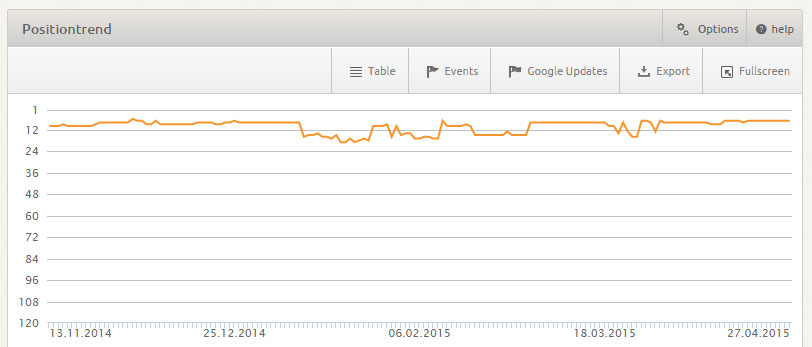Keywords which are tailored to your target audience continue to play a key role in search engine optimization. Webmasters should therefore always keep a close eye on their website’s most important keywords in order to be able to react as quickly as possible to any changes in ranking. However, keyword monitoring is not only important for quickly recognizing negative trends, it also enables you to analyse the success of your SEO strategies. It is therefore vitally important that Webmasters understand the key aspects of keyword monitoring in order to optimize the presence of their website or online shop in search engines.
What is Keyword Monitoring?
In order to attract users from a target group to a website via search engines, webmasters must first identify key terms appropriate to their particular business which are frequently searched for by users. For online shops for instance, these are often the names of products stocked on the website. These search terms, also known as keywords, are important for search engine optimization, since it is with these in mind that the relevant sub-pages in a domain should be optimized. Keyword Monitoring enables you to calculate the ranking of your online presence for particular keywords. The higher the ranking for suitable keywords with a high search volume, the more likely it is that users will choose to visit your website or online shop. Since rankings can fluctuate greatly, it is all the more important to monitor any changes and keep a close eye on ranking development and current positions. To this end, it is also possible to monitor the development of a single keyword over a particular period of time as well as its current position in search engines, all made simply by the implementation and evaluation of a good SEO strategy.
Keyword Monitoring in XOVI V3
The importance of keyword monitoring is reflected in the XOVI Suite V3. Because XOVI places particular emphasis on relevant keywords, keyword monitoring has its own independent section in the Suite. Particular emphasis is placed on daily ranking positions enabling webmasters to keep constant track of developments.
What is so special about keyword monitoring from XOVI?
In XOVI the calculation of detailed and up to date keyword positions is paramount. The Monitoring Tool features:
- Keyword monitoring from 196 countries
- Keyword monitoring in Google, Bing and Baidu
- Evaluation of up to 2,500 keywords per week (or more)
- Pre-set time intervals (monitoring 1-7 times a week)
- Live Monitoring
- Universal search result monitoring
- Information on CPC and search volume
- Keyword history
- Keyword positions by API
- Exportation of data in PDF reports
How is the keyword monitoring section structured?
In order to implement keyword monitoring effectively a project must first be created to which the relevant keywords can be assigned. In the XOVI Suite V3 the keyword monitoring section is divided up into six sub-sections allowing for more detailed and better structured monitoring. The six sections are:
- Overview
- Monitored keywords
- Visibility
- Domain analysis
- Ranking development
- Keyword analysis
Overview
Once keywords have been entered and the initial keyword positions have been calculated, the overview will contain all the important information regarding ranking keywords, average positions and the number of new and lost keywords in all available projects. With the help of graphics and charts, you can also see the ratio of ranking to non-ranking keywords and the sites on which these can be found enabling webmasters to see, at a glance, how the keywords in each projects are developing.
Monitored keywords
The monitored keywords section contains all keywords which are currently under surveillance. Here, webmasters can find all information about keyword positions including: the search engines in which they have been monitored, how many documents for the keyword are available in the search engine index, keyword search volume, CPC, and competitor density. Thanks to XOVI’s comprehensive filter system, webmasters can quickly identify particularly relevant keywords. To make things even easier, keywords can also be marked for processing by a certain function using the “select action” tool.
- Select action
- Remove keywords
- Update keywords
- Add label
- Remove label
- Add monitoring day
- Remove monitoring day
- Edit domain
- Edit keyword
- Change universal search settings
- Launch live keyword monitoring
- Add keywords for new countries and domains
New keywords can always be added so that these are monitored in future too. To add keywords to keyword monitoring, apply the following settings:
- Project (Which project should the keywords be applied to?)
- Domain (Which domain should the keywords be applied to?)
- URL (Which URL should the keywords be applied to?)
- Keywords (Which keywords should be added?)
- Search engines (In which search engines should positions be monitored?)
- Labels (Should keywords be assigned to a keyword set?)
- Day(s) (On which days should keyword monitoring be carried out?)
- Universal search (Exclude universal search positions or not?)
- Optimization start (From what date should keywords be monitored?)
- Note (Add this action to the calendar?)
In this way, particularly important keywords can be checked “live” in just a few clicks.
Visibility
This section contains the OVI of all monitored keywords. Webmasters can also decide to only display the OVI development of certain labels in order to obtain a more transparent overview of the development of their own keyword clusters.
Domain analysis
Whilst the overview contains all currently monitored keywords, the Domain Analysis section allows webmasters to analyse only those keywords being monitored for a certain domains. The section contains the following information:
- Ranking keywords
- Average position
- New keywords
- Lost keywords
- Ratio of ranking / non-ranking keywords
- Breakdown (Rankings / positions)
Ranking Development
During the search engine optimization process, not only should current rankings be checked but also the way in which keywords have developed over time. If, for instance, you have implemented a new content strategy or have undertaken structural changes to a website, it is important to check whether these changes have had a positive or negative effect on the rankings of important keywords. With the help of “Ranking development”, webmasters can obtain a detailed impression of keyword development which they can use to determine the extent to which optimization strategies have been successful. In order to present the development as clearly as possible, positive trends are highlighted in green and negative ones in red. The application of filters is important here too. By using filters, webmasters can access the necessary information in just a few clicks.
Keyword analysis
Whilst other parts of the XOVI Suite focus on the processing and analysis of several keywords, in “keyword analysis” the focus is on single keywords. The most important information about a keyword is displayed in a table in relation to the given domain.
The following information is available:
- Current position
- Best ever position
- Current search result hits
- Average position (overall)
- Average position (last 30 days)
- Greatest positive change (position and date)
- Search engine (index)
- Domain
- Last update at (time) on (date)
- Current ranking URL
- Max number of search results (quantity and date)
- Start of optimization (date)
- Change since start of optimization
- Monitor position on the following days: (list of days)
Position trends are also displayed graphically as well as in a table, allowing for easier analysis of the success of SEO measures.

The top 120 search results are also given as well as the number of documents in the selected search engine index, enabling webmasters to obtain a better overview of the performance of a particular keyword.
Monitoring chance keywords with XOVI
Webmasters who would like to attract more target group specific traffic via organic searches in search engines are faced with countless different possibilities to optimize their website. One way of generating more traffic in a short space of time is chance keywords. Whilst keyword research is likely to also displays keywords with which a website or online presence is not found, the “chance keywords” are those keywords which already have good rankings, the use of which can result in higher website positionings with little effort. Just remember that chance keywords must also:
- Be relevant to your target group
- Suit your business model
- Have a relatively high search volume
- Be able to achieve a top 10 position
Instructions
A list of all chance keywords for existing projects can be found in the “chance keywords” subsection in the “Keywords” section of the XOVI Suite. Here, webmasters can use the relevant filters to determine keywords which fulfil the criteria listed above and which are therefore relevant for use in future SEO strategies. Once keywords have been decided upon, select them and add them to keyword monitoring using the “select action” menu.
- Select action
- Add keywords to monitoring
- Launch live keyword monitoring
Once added to the monitoring tool, these keywords become the focus of analysis, enabling webmasters to determine the extent to which SEO measures for documents related to these keywords are successful.
